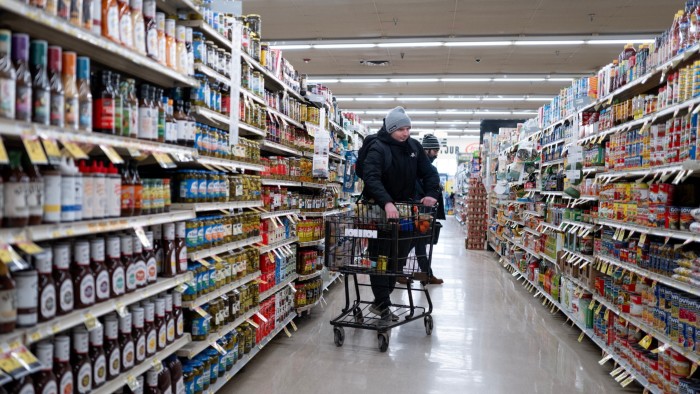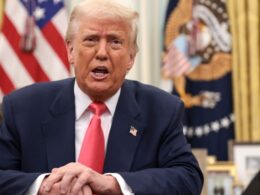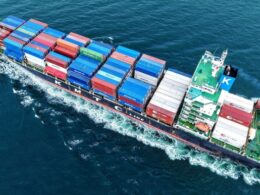Unlock the Editor’s Digest for free
Roula Khalaf, Editor of the FT, selects her favourite stories in this weekly newsletter.
It would reach Himalayan heights of foolishness for Canada, China and Mexico to assume they’ve seen the last of Donald Trump raising tariffs. This week their governments all coped with the threat rather well. To forestall the threat of 25 per cent import taxes, Mexican President Claudia Sheinbaum and Canadian Prime Minister Justin Trudeau executed what I call the “soyabean shuffle”. The term recalls the then European Commission president Jean-Claude Juncker forestalling car tariffs in 2018 by promising Trump that Europe would buy more US soyabeans, which it already was.
Mexico and Canada this week announced the deployment of troops and border staff who were largely there already to combat the flow — minimal in Canada’s case — across the border of the opioid fentanyl. China imposed modest rises in energy tariffs, more clampdowns on exports of critical minerals (which have never really worked) and a vaguely worded investigation into Google.
But Trump will come back for more, and broaden his targets to include the EU and middle-income economies aside from China. He has a particular animus against Vietnam, which he correctly views as a supply chain stop-off and offshore production platform for China. Exporters cut out of the US must find new markets.
I’ve argued that the threat of US tariffs against China diverting Chinese exports into those countries and worsening “China Shock 2.0” can be overdone. Trump’s first term showed emerging economies taking China’s share of the US import market.
But the US trying to reduce overall imports will be seriously destructive to foreign exporters and to itself. This week’s elimination of the $800 “de minimis” customs-free allowance for China will clobber Chinese ecommerce companies such as Temu and Shein. Yet Trump is also contemplating imposing tariffs and ending those de minimis exemptions for other countries.
Trade between middle-income economies is becoming increasingly important. The consultancy BCG projects goods trade between China and other emerging economies rising by an annual growth rate of nearly 6 per cent in real terms between 2023 and 2033. Growth in trade between the high-income countries and China will barely be positive.
But some of that just reflects adding extra stages to the value networks delivering goods to the US. High-income economies are not being cut out of the picture. Trade between middle-income countries excluding China will rise by 3.8 per cent and between those middle-income and rich countries by 3.7 per cent.
Certainly, the world can adjust. Growth models can change. But the voracious American consumer will be hard to replace quickly. Currently, as trade has recovered from the initial shock of the Ukraine war, US imports have increased far faster than the world as a whole, while Chinese import growth has fallen. As David Lubin of the Chatham House think-tank in London (habitual disclaimer: I’m an unpaid associate fellow there) puts it, exporters find themselves caught in a battle of mercantilisms, with both China and the US seeking to increase exports relative to imports.

China’s economic travails, with domestic demand weak after the bursting of the property bubble, has pushed Beijing and regional governments back towards their familiar export-led model. In terms of volume, Chinese exports rose at an annual rate of 13 per cent in the third quarter of last year, far faster than world import growth at less than 1.5 per cent. Lubin bluntly calls this a “predatory” trade policy, aiming to capture market share from other countries. He says the simultaneous drive to reduce imports has a geopolitical end, “to make China less dependent on the rest of the world and the rest of the world more dependent on China”.
In the past couple of years there has been a wave of antidumping and other emergency tariffs in developing economies to protect their companies from Chinese competition. So far they have concentrated on industrial inputs such as steel — politically high-profile but not a huge part of global value-added in trade. But if US demand is choked off, the pressure to broaden them will increase.
As for other sources of final demand, emerging economies themselves, particularly in Asia, have been consuming more as they get richer. But east Asian countries are typically net exporters: Malaysia, Singapore, Thailand and the Philippines have generally run current account surpluses since the Asian financial crisis in 1997-98, as have South Korea and Japan. Meanwhile, the EU, struggling to raise growth while Germany remains obsessed with exports, is also unlikely to pick up the consumption baton.
This may add up to trouble ahead for countries exporting to the US, especially heavily exposed economies like Canada and Mexico. Trump’s economic policies will encourage a wider US trade deficit, the opposite of what he wants. His planned sweeping tax cuts will increase consumer demand and suck in imports. His tariffs will make US exporters less competitive by strengthening the dollar, which import taxes tend to do.
It will not be pretty if Trump starts deploying tariffs all round to stop the US being a consumer of last resort while implementing policies that will ensure it remains so. Exporters will be hunting round the world for scarce demand. As I’ve said before, the real threat to the global economy is not the rejigging of supply chains. It’s the danger that the most reliable market for global exports decides to crunch economic growth to get its trade deficit down and there’s not enough demand elsewhere to replace it.
Source link









